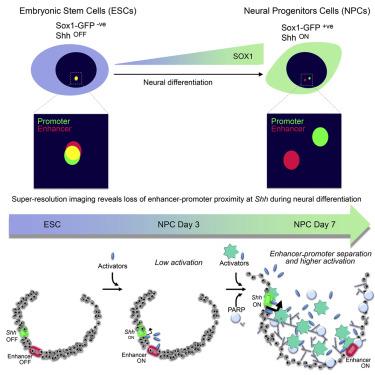Activation at a distance: new evidence on enhancer-gene communication
Recent findings from scientists at the MRC Human Genetics Unit have shed new light on how enhancers and genes communicate at great distance along the chromosome: September 2019

Our genes are switched on at the correct time and place during development by parts of our DNA called enhancers. Mutations in these enhancer regions of DNA can cause severe genetic disease and the variation in enhancer sequences from person to person lies behind our susceptibility to diseases which are more common.
As enhancers can be located far from the genes that they control on the chromosome – as far as one million bases away – the way in which these two regions communicate at such distances has fascinated researchers for years.
To date, it has been widely assumed that this communication must involve the three-dimensional folding of the genome and that the chromosome most likely loops around to bring the enhancer and gene closer together.
Using advanced microscopy, researchers at the MRC Human Genetics Unit recently examined the spatial relationship between an important developmental gene – Shh – and its enhancers. In doing so, the team have uncovered evidence which suggests that, in some cases, enhancers may actually move further away from the genes that they switch on.
This unexpected finding challenges the long-standing idea that gene and enhancer are brought closer together through chromosome looping, indicating that new models of enhancer-gene communication should be explored.
Understanding the normal processes by which enhancers control genes is the fundamental first step in determining how this can go wrong in disease.
The study was published in Molecular Cell on 4 September 2019: https://doi.org/10.1016/j.molcel.2019.07.038
Related Links:

